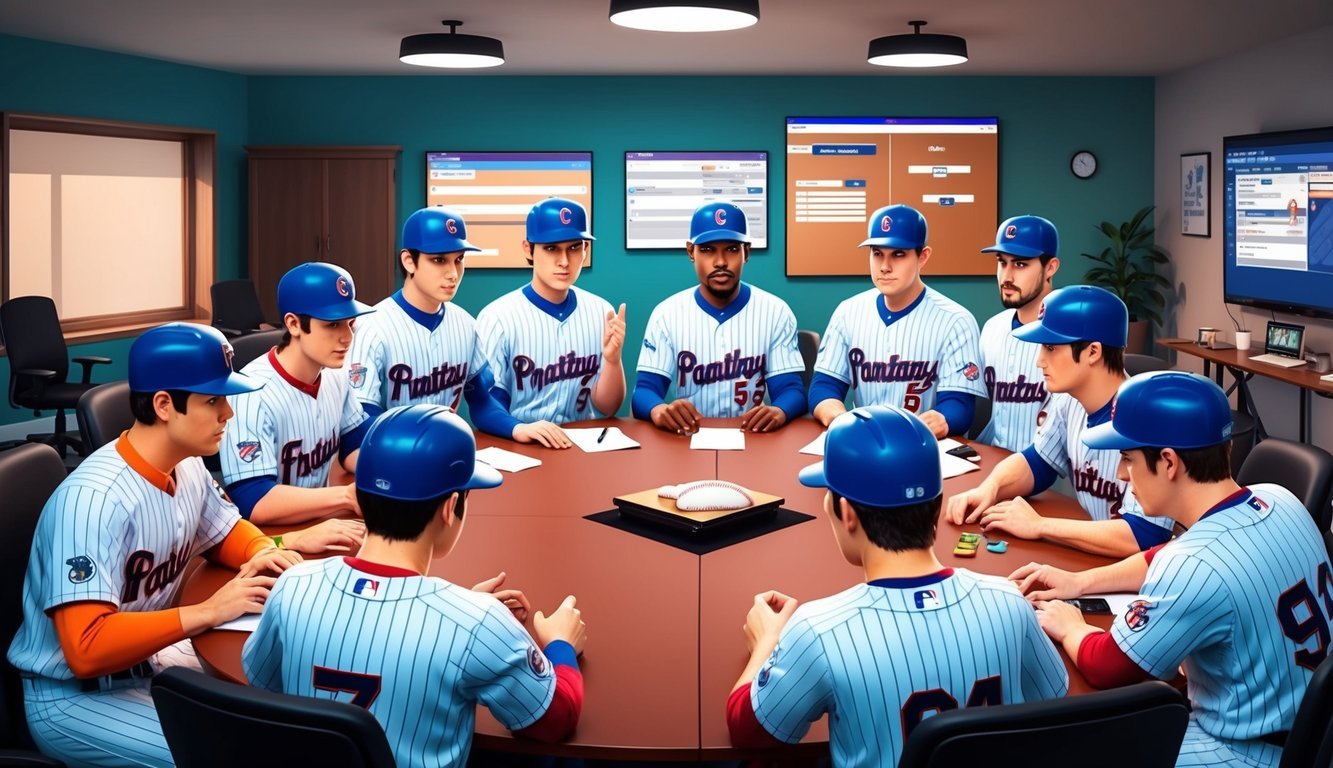Interactive fantasy baseball brings the excitement of America’s pastime to fans’ fingertips.
This engaging online game allows participants to assemble virtual teams of real MLB players and compete against friends or strangers.
Points are earned based on the actual statistical performance of selected players throughout the baseball season.
Fantasy baseball platforms offer customizable league settings, live scoring updates, and in-depth player analysis to enhance the experience.
Managers can make trades, pick up free agents, and adjust lineups daily.
This interactive element keeps fans involved with every pitch, hit, and stolen base across Major League Baseball.
They analyze player performance, track injuries, and strategize for upcoming matchups to maximize their team’s success.
From monitoring statistics to making last-minute roster changes, every decision impacts the standings.
Just like coaches rely on home team dugout essentials to keep their players prepared, fantasy managers use data and insight to stay competitive throughout the season.
As the 2024 season approaches, fantasy baseball enthusiasts are gearing up for another thrilling year of virtual team management.
Popular sites like ESPN, CBS Sports, and Yahoo provide free and paid league options for players of all skill levels.
Whether you’re a seasoned veteran or new to the game, interactive fantasy baseball offers a fun way to stay connected to the sport and compete with fellow fans.
The Basics of Fantasy Baseball
Fantasy baseball simulates managing a real baseball team.
Participants draft players, make lineup decisions, and compete based on their players’ real-world performances.
Success requires understanding player roles, league structures, and scoring systems.
Understanding Player Positions
Fantasy baseball rosters mirror real MLB teams.
Most leagues use standard positions: C, 1B, 2B, 3B, SS, OF, and P. Some include utility (U) spots for flexibility.
Outfielders (OF) are often split into LF, CF, and RF.
Starting pitchers (SP) form the rotation, while relief pitchers (RP) handle bullpen duties.
Multi-position eligibility adds value to players who can fill different roster spots.
Knowing position scarcity helps in drafting.
Shortstops (SS) and catchers are often harder to find quality options for compared to first basemen or outfielders.
League Types Explained
Fantasy baseball offers various league formats.
Rotisserie (or “roto”) leagues rank teams across multiple statistical categories.
Teams earn points based on their standing in each category.
Head-to-head leagues pit teams against each other weekly.
Matchups are decided by category wins or total points scored.
Dynasty leagues keep players year-to-year, mimicking real MLB team management.
Keeper leagues allow teams to retain a set number of players each season.
Public leagues are open to anyone, while private leagues are often formed among friends or colleagues.
Scoring Systems Overview
Points leagues assign values to player stats.
For example, a single might be worth 1 point, while a home run earns 4.
Pitchers typically earn points for strikeouts and innings pitched.
Rotisserie leagues use set categories.
Common hitting categories include Runs, Home Runs, RBIs, Stolen Bases, and Batting Average.
Pitching often covers Wins, Saves, Strikeouts, ERA, and WHIP.
Some leagues use on-base percentage (OBP) instead of batting average.
Others might include holds for relief pitchers or quality starts for starters.
Custom leagues can adjust categories or point values to emphasize different aspects of baseball performance.
Pre-Draft Strategies
Preparing for a fantasy baseball draft requires careful planning and research.
Successful managers utilize key tools and techniques to gain an edge before draft day arrives.
Analyzing Player Projections
Player projections form the foundation of draft preparation.
Reliable projection systems use statistical models to forecast player performance.
Managers should compare projections from multiple sources to identify consensus expectations and potential outliers.
Pay close attention to projected stats in each scoring category.
This helps pinpoint players who excel in specific areas.
Create custom rankings based on your league settings and scoring system.
Adjust projections for players changing teams or roles.
Don’t ignore injury risks and playing time concerns when evaluating projections.
Young players and prospects often have less reliable projections due to limited MLB data.
Use projections as a guide, but consider other factors like ballpark effects and lineup context.
Mock Drafts and Their Importance
Mock drafts provide invaluable practice and insight before the real thing.
They help managers test different strategies and get a feel for player values.
Participate in mocks with settings that match your actual league.
Track average draft position (ADP) data from mocks to spot trends and potential bargains.
This reveals which players are being over or undervalued by the market.
Pay attention to positional scarcity and how quickly certain player types are being selected.
Use mock results to refine your draft plans and identify target players in each round.
Practice drafting from different slot positions to prepare for various scenarios.
Mock drafts also help managers get comfortable with the pressure and pace of live drafting.
Evaluating Baseball Prospects
Prospects can provide huge value in fantasy leagues, especially keeper and dynasty formats.
Research top MLB pipeline rankings and scouting reports to identify high-upside young talent.
Track spring training performance and roster battles involving prospects.
Consider a prospect’s ETA and likely role upon promotion.
Power hitters and starting pitchers typically make the biggest immediate fantasy impact.
Speed-first prospects can contribute in steals even with part-time at-bats.
Catchers like Yankees prospect Ben Rice often need more development time.
Be cautious with pitching prospects, as their workloads are usually limited initially.
In redraft leagues, focus on prospects with clear paths to playing time.
Dynasty managers should target the best long-term talent regardless of 2024 outlook.
Managing Your Team

Effective team management is crucial for success in fantasy baseball.
It requires strategic decision-making, staying informed on player performance, and adapting to changing circumstances throughout the season.
The Art of the Trade
Trading is a key aspect of fantasy baseball strategy.
Identify areas where your team needs improvement and target players who can fill those gaps.
Look for trade partners whose needs complement yours.
Be fair in your offers to build trust with other managers.
Consider buying low on underperforming stars who may bounce back.
Conversely, selling high on players overperforming their typical stats can yield valuable returns.
Stay updated on player news and injuries to spot trade opportunities.
Don’t be afraid to propose multi-player deals.
These can help both teams address multiple needs simultaneously.
Remember, patience is often rewarded in negotiations.
A rejected offer today might lead to a better deal tomorrow.
Navigating the Waiver Wire
The waiver wire is a goldmine for savvy managers.
Check it regularly for emerging talents, hot streaks, and injury replacements.
Act quickly on promising free agents before others snatch them up.
Keep an eye on minor league prospects nearing promotion.
Adding them early can give you a competitive edge.
Watch for players returning from injury who may have been dropped by impatient owners.
Be strategic with your waiver priority or FAAB budget.
Save resources for impact players rather than making frequent low-impact moves.
Consider streaming pitchers based on favorable matchups, especially in head-to-head leagues.
Setting Optimal Lineups
Maximize your team’s potential by setting smart lineups daily.
Review player matchups against opposing pitchers or teams.
Factor in ballpark effects, weather conditions, and recent performance trends.
Utilize platoon advantages by starting left-handed hitters against right-handed pitchers and vice versa.
For pitchers, consider their historical performance against specific teams or at certain ballparks.
Pay attention to playing time trends, especially for part-time players.
Injuries or slumps can create opportunities for bench players to shine.
Stay flexible and be ready to adjust your lineup based on late-breaking news or unexpected lineup changes.
Value in Fantasy Leagues

Understanding player value is crucial for success in fantasy baseball leagues.
Accurate valuations help managers make smart draft picks, trades, and roster decisions throughout the season.
Determining Player Dollar Values
Custom dollar values provide a standardized way to compare players across positions.
Many fantasy platforms offer calculators where managers can input their league settings and roster requirements to generate tailored values.
These tools often use projected stats and point totals to estimate each player’s worth.
For example, ESPN’s Fantasy Baseball Value Calculator lets users enter their roster and scoring system for personalized dollar values.
The results include projected stats and points, giving managers a clear picture of expected production.
Some savvy managers create their own valuation models using spreadsheets.
This DIY approach allows for fine-tuning based on league specifics and personal player projections.
Ranking Pitchers for Your Roster
Pitcher rankings require special consideration in fantasy leagues.
Unlike hitters who contribute across multiple categories, pitchers’ value can vary widely based on league format.
In points leagues, workhorses who rack up innings and strikeouts often rise to the top.
Category leagues may place more emphasis on ratios like ERA and WHIP.
Key stats to weigh for starting pitchers:
- Strikeouts
- Innings pitched
- ERA
- WHIP
- Wins potential
For relievers, saves and holds become crucial depending on league settings.
Elite ratios can provide a boost in roto formats.
Customizing League Settings
Tweaking league settings can dramatically impact player values.
Savvy commissioners fine-tune their leagues to create the most engaging experience.
Popular customization options:
- Scoring categories (standard 5×5 vs. expanded)
- Roster size and positions
- Player acquisition methods (draft, auction, waivers)
- Transaction limits
- Innings or games started caps
Adding categories like quality starts or on-base percentage can shift the balance between pitchers and hitters.
Deeper leagues with more roster spots tend to flatten values across the player pool.
Auction drafts offer the most flexibility, allowing managers to allocate their budget based on personal strategy.
Snake drafts are simpler but can lead to positional runs.
Staying Informed and Ahead

Keeping up with MLB news and leveraging fantasy platforms are crucial for success in interactive fantasy baseball.
These strategies help players make informed decisions and gain a competitive edge.
Keeping Up With MLB and Player News
Following MLB updates is essential for fantasy baseball success.
Set up alerts for your players on sports apps and websites.
Check injury reports daily to avoid fielding injured players.
Follow beat writers on social media for insider info on teams like the Braves and Twins.
Keep an eye on minor league callups – they can be game-changers.
Watch highlight reels to spot emerging talent.
Pay attention to trade rumors, as they can impact player values.
Don’t forget to monitor weather forecasts for potential game postponements.
Leveraging Fantasy Platforms
Fantasy platforms offer valuable tools to stay ahead.
You can use Yahoo’s player comparison feature to evaluate trades.
Then, check daily matchup ratings to optimize your lineup.
Take advantage of player news feeds for real-time updates.
Explore stat projections to guide your roster decisions.
You can also participate in mock drafts to test strategies.
Join fantasy forums to discuss player trends with other managers.
Lastly, use watchlists to track potential waiver wire pickups.
Consider paid subscriptions for advanced analytics.
Many platforms offer mobile apps for on-the-go management.
Don’t overlook the importance of studying league settings and scoring systems.
